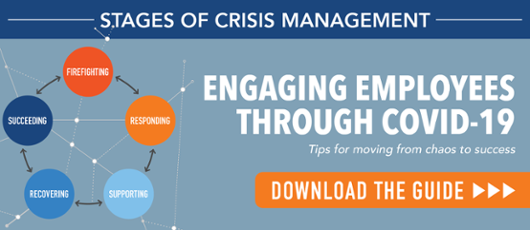Leading Through Change: How to Create Stability in the Workplace
 In times of upheaval, good leadership is more important than ever to ensure your people are happy, safe, and productive. But how can you lead your people successfully under turbulent and stressful conditions? How can you create stability and engage employees amid disruption?
In times of upheaval, good leadership is more important than ever to ensure your people are happy, safe, and productive. But how can you lead your people successfully under turbulent and stressful conditions? How can you create stability and engage employees amid disruption?
These questions are particularly pressing in an era when technological advancement, innovation, digital transformation, and disruption are the new normal. Throw in the uncertainty of global markets, industry regulation, and politics, and it may seem like stability is impossible.
Creating stability may be a challenge, but it is crucial for your business’ success.
Gallup research shows that employees have four basic needs in order to feel secure and engaged at work—trust, stability, compassion, and hope. Leaders who can address these needs will be able to navigate change with clarity and purpose while keeping their employees engaged.
Learn why stability matters so much and use these tips to build stability amid uncertainty and inspire those you lead.
- Provide resources to succeed
- Communicate honestly
- Share a plan of action
- Check in often
- Lead with optimism
Why stability matters
Stability is necessary for people to do their best work. During times of change or uncertainty, stability is often shaken and can disrupt your employees’ ability to focus, adapt, and thrive.
For example, if your organization is going through a merger, your employees may feel unsettled and uncertain about what that means for the future of the company and their jobs. This uncertainty can make it difficult for individuals and teams to stay engaged and can impact their performance.
Whatever the cause of disruption, managers and leaders must build stability if they want their organization to succeed.
There are two main elements of stability: physical and psychological.
- Physical stability means you are physically safe and have the tools and resources you need to do your work safely and effectively.
- Psychological security impacts your sense of wellbeing, your trust in leaders and in the organization’s future, and your overall optimism and resilience. These traits are called psychological capital.
Psychological capital is characterized by having:
- Confidence to accomplish challenging tasks
- Optimism for succeeding now and in the future
- Perseverance to work toward goals and adapt goals as needed
- Resilience to bounce back from setbacks and continue moving forward
How well you develop and support your employees’ psychological capital will determine how successful you are at fostering stability and employee engagement. In fact, employees are nine times more likely to be engaged in their jobs if they feel the company's financial future is secure.
Leaders must be able to address both physical and psychological factors to build stability within their teams and organizations.
5 steps to create stability amid disruption
Creating stability won’t happen overnight—but there are actions you can take that will build trust and confidence in you and your organization. This will help your employees feel secure and empowered to do their best work, even during times of uncertainty.
Steady the ship and stimulate engagement by focusing on these five key steps.
1. Provide resources to succeed.
Make sure your employees have the tools, technology, and resources they need to do their job. This one might seem like a no-brainer, but in the midst of change, the resources employees need may also evolve.
For example, if your organization is adopting new technology, do your employees have the training and resources to learn the new technology and implement it safely and effectively? Check in regularly with employees and team managers to assess what they need and then make sure they get it.
2. Communicate honestly.
Trust is built on honest communication and a personal relationship. In times of change, it can be tempting as a manager to focus solely on the positive in an effort to boost morale and reassure your employees.
However, while positivity is important (more on that later), honest communication also means tackling difficult conversations and topics.
Focus on these behaviors to build trust and safety for your team:
- Be present and transparent. Don’t avoid your employees—or a difficult conversation. Show up and address the concerns of the moment. What challenges is your company facing? What are the risks? What is the plan to address and mitigate those risks?
- Keep employees informed by checking in regularly with updates—even if nothing new has developed, let them know.
- Create context. Contextualize the issues so your employees understand what led to the current environment and why you (or other leaders) made certain decisions. For example, if the company is going through a merger, explain why the merger was necessary or strategically important, and what will happen to existing teams and jobs.
Some of these topics will be appropriate in a team or company-wide meeting. Save more personal topics, like the future of an individual’s job, for one-on-ones.
3. Share a plan of action.
Change or disruption often creates anxiety and uncertainty about the future. Combat that anxiety and create stability for your teams by sharing a plan of action and following through on those commitments.
Paul Berg says, “Leaders don't need to predict the future, but they must be predictable now and in the future. It's hard to trust an erratic leader.”
And trust is crucial. When employees trust their leaders, one in two are engaged. When employees don't find leaders trustworthy, only one in 12 are engaged at work.
Plans help people feel a sense of control and focus on things they can do, which is especially important when many things might be out of their control. A plan of action also maps out your goals and priorities, which provides direction for your organization and teams.
4. Check in often.
It’s not enough to have one all-hands meeting and then go back to business as usual. Managers should be checking in with their team members often so they know how their employees are doing and what their evolving needs may be.
How frequently you check in with your employees will depend on the situation and needs of your team. However, a good target (particularly during times of disruption or rapidly evolving changes) is to conduct formal one-on-one meetings at least once a month.
But don’t limit your interactions and check-ins to formal one-on-one meetings. Use email, chat, or a quick water cooler interaction to see how your employees are coping. Do they seem motivated and optimistic? Or tired, bored, or anxious?
Regular check-ins help you keep your finger on the pulse and be aware of the needs and reactions your team has to change. This is especially important for gauging their emotional wellbeing. If you see where their psychological capital is depleted, you can address those needs more effectively.
5. Lead with optimism.
Hope and optimism are part of your employees’ psychological capital and have a significant impact on engagement and performance. Uncertainty and change can become breeding grounds for pessimism and demotivation, so it is important that leaders foster hope through example.
While it is important to be honest, you can still inspire hope and positivity among your employees by leading with optimism.
- Highlight the constants that remain in your organization, operations, or business. When things are changing, emphasizing what hasn’t changed can help your team view the situation in a more positive and balanced lens.
- Recognize progress and achievements. Even if you’re still in the thick of things, focus on what is going well, and what steps you (or your employees) have already made towards your goals.
- Share why you are hopeful for the future. When outlining your plan of action or a new goal, explain why you are confident that your team will succeed and achieve those targets.
These may seem like small things, but together they make a big difference in how your employees perceive changes and move through them.
In times of crisis or disruption, people turn to their leaders for answers. Luckily, you don’t have to have all the answers. But you do need to address your employees’ core needs and build their physical and psychological security.
Use these tips to create stability, trust, and confidence during times of uncertainty, and keep your employees engaged. If you're looking for additional support, download our leadership guides for Engaging Employees Through COVID-19: Tips For Moving From Chaos to Success.







